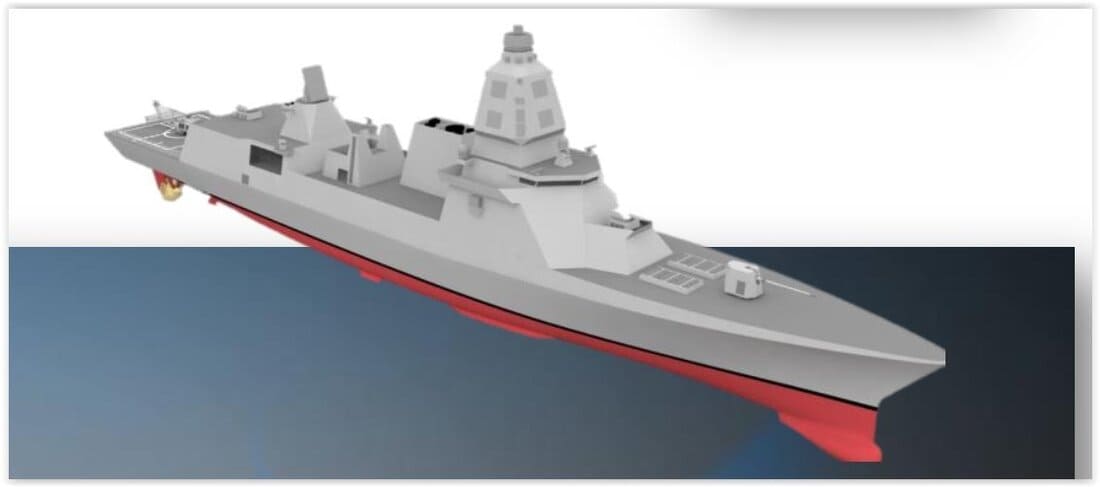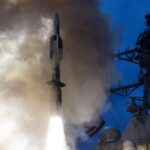Türkiye has concluded two linked naval contracts with the state-owned shipbuilder ASFAT: one for a TF-2000 air-defense destroyer and another for four offshore patrol vessels. The agreements were signed at IDEF 2025 in Istanbul by ASFAT CEO Mustafa İlbaş and Admiral Ercüment Tatlıoğlu, Commander of the Turkish Naval Forces. According to defense officials, the destroyer is scheduled to launch in 2028 and enter service in 2030, while the patrol vessels will be delivered within thirty-six months of contract award. Financial terms were not dislcosed.
This procurement effort addresses both ends of the Navy’s surface-fleet requirements. The TF-2000 destroyer will provide advanced anti-air warfare protection for task groups, whereas the offshore patrol vessels will undertake regular patrol operations in the Aegean, Mediterranean and Black Seas.
According to industry sources, the contracts focus on using local suppliers and sticking to firm timelines, instead of relying on offset deals or outside financing. That way, both the work and the risks stay within Turkey’s trusted shipyard network.
TF-2000 Destroyer: 149m Hull, 96-Cell VLS, and Fixed-Face AESA
Program briefs at the show describe a 149-meter destroyer in the 8,000-ton class with a beam a little over 21 meters. The propulsion layout is CODOG, set for more than 28 knots at flank and efficient transit speeds in the mid-teens. Designers kept weight and power margins for sensor and effector growth so the ship can absorb later blocks without deep structural work.
The combat system is built around two indiginous vertical‐launch modules, providing a total of 96 missile cells. The radar suite employs ASELSAN’s fixed‐face ÇAFRAD family, with X-band multi-function panels dedicated to tracking and fire control and S-band panels for volume search. The forward battery features a domestically produced 127 mm gun capable of firing guided munitions for naval gunfire support and surface engagments. Close-in defense is layered, combining missiles, the GÖKDENİZ gun system, and soft-kill decoys. Subsurface detection integrates a bow-mounted array with a low-frequency towed sonar. Aviation facilities include a hangar and deck spot for an S-70B-class helicopter, plus additional spots for unmanned aerial vehicles.
At IDEF, the revised topside layout attracted attention. Mast positions and radar face orientations have been optimized to minimize mutual interference and ensure unobstructed coverage in cluttered coastal airspace. Removable panels and dedicated access routes around the radar faces and emitters permit module replacement without extensive hot work. According to shipyard planners this focus on maintainability is intended to reduce dockside time during future radar upgrade cycles.
An ASFAT spokesperson outlined the near-term construction schedule: steel cutting is slated for November 2025 at the Istanbul Naval Shipyard, with the first complete hull block to be delivered before year end. Once welding sequences and lift procedures are validated, the yard will proceed to serial production of approximately 60 blocks. The project remains anchored to three principal milestones: launch in 2028, acceptance in 2030, and commencement of initial block fabrication immediatly following the late-2025 steel cutting. A multiprogram ceremony on January 2, 2025, formally inaugurated construction of the TF-2000 destroyer alongside the MUGEM light aircraft carrier and the MİLDEN submarine; the upcoming November event will focus exclusivly on fabrication of the lead TF-2000 hull.
Weapons planning leans on national missiles. A long-range SAM tier, a medium-range tier sized for raid handling, and an ASW rocket option can live in the 96-cell allowance. The ADVENT combat-management system will integrate radar, VLS, EW, and links. The ship will share tracks and fire-control quality data with I-class frigates and shore sensors through the Navy’s link architecture. That enables cooperative engagements in crowded littorals and adds reach for defended-asset bubbles around amphibious and carrier groups.
System Integration, Testing Phases, and Yard Allocation for TF-2000 Build
Program risk sits in software and integration, not hull steel. Radar-to-launcher timing, track deconfliction, and engagement scheduling form the dense node in the plan. The Navy and ASFAT outlined a staged test flow: power-on checks at the pier, topside integration runs with instrumented targets, then a series of sea trials that build from navigation to full combat-system events. Yard teams mapped lift plans for heavy blocks and VLS trunks to avoid rework during alignment.
Specification snapshot:
- Length 149 m; beam ~21 m; full load ~8,000 t; top speed above 28 kn.
- Two indigenous VLS modules, 96 total cells; 127 mm main gun; GÖKDENİZ CIWS and decoys.
- ÇAFRAD fixed-face AESA suite (X-band MFR, S-band long-range search); integrated EW.
- Bow and towed sonars; aviation for S-70B-class helicopter plus UAVs.
- ADVENT CMS and national data links; launch 2028; delivery 2030; steel cut targeted for November 2025.
ASFAT will assemble the destroyer at Istanbul Naval Shipyard and draw on other state yards for heavy support. That network gained flexibility in 2024 with a large floating dock for submarines, which eases pressure on cranes and deep-water berths during parallel programs. Leadership kept the prime role with a government entity to simplify access to classified interfaces and to reassign resources during integration spikes. Private yards remain in the chain as block, outfitting, and subsystem partners.
The Navy’s mission set for TF-2000 spans air defense for expeditionary groups built around TCG Anadolu and the future carrier, sea-control patrols, and contributions to national air-and-missile defense along the littorals. An official at the booth framed the goal bluntly: “This ship is going to be a game changer in air defense, not only at sea but for the mainland as well.” The comment matched the heavy radar and VLS focus across the model and display boards on the floor.
Crew training will stage in layers. Simulator time for the combat team ramps well before launch. Radar and CMS labs ashore will run parallel with pier-side integration. The aviation detachment joins early so the first sea trials can clear flight operations without delay. The Navy plans a deliberate pipeline for watchstanders so the commissioning crew arrives with time on ADVENT and ÇAFRAD in a lab setting.
Ada-Based Offshore Patrol Vessels
The second package orders four OPVs derived from the Ada-class hullform. The Navy asked for long-leg patrol ships with steady seakeeping and low ownership costs. The selected platform uses CODELOD propulsion: diesel-electric for quiet, efficient loiter and diesel-mechanical for transits and sprints. Top speed sits in the mid-20-knot range. The hull runs about 99 meters with a beam around 14.4 meters and a displacement near 2,300 tons in the baseline patrol fit.
The bridge, ops room, and consoles follow the Navy’s current human-machine interface standards. That choice shortens pipelines for watch officers moving between corvettes and patrol units. The design reserves weight and space for later combat-system growth without forcing structural surgery.
Weapon fit is modular and mission-driven. A 76 mm or 57 mm gun forward anchors the surface layer. Stabilized 25 mm mounts and crew-served weapons cover small-boat threats. Short-range air defense or a point-defense missile fit can be added if tasking requires it. Interfaces exist for anti-ship missiles and even a compact vertical-launch set in future increments if the Navy decides to up-arm selected hulls.
OPV Production and Mission Profile
Aviation capacity includes a medium helicopter deck and spots for VTOL UAVs that extend surveillance and search-and-rescue reach. A stern ramp serves a high-speed RHIB for boarding, search, and rescue. The boat bay and davits can support dual craft if the manning plan allows.
The mission list is steady and familiar: maritime interdiction, fisheries enforcement, counter-smuggling, SAR, and protective patrols around energy sites and cables. Four OPVs let fleet planners hold persistent lines without pulling I-class frigates or Ada corvettes off higher-end work. The Navy already has experience with the Hisar OPV line; sea trials for the first hull started in late 2024, which gives crews and maintainers a head start on routines and spares.
Production will take place in Istanbul within the 36-month window. The likely sequence pushes the first hull to builder’s trials around the two-year mark, with the others following at regular intervals after machinery and combat-system alignments stabilize. The domestic supply base-diesel-electric gear, switchboards, small-caliber weapons, RHIBs, and mission electronics-already supports OPV work, which reduces risk on the schedule.
A brief capability snapshot for the OPVs:
- ~99 m length; ~14.4 m beam; ~2,300 t displacement; endurance for long patrols.
- CODELOD propulsion; ~24 kn class top speed; efficient diesel-electric loiter.
- Modular armament: 76/57 mm gun, stabilized mounts, optional short-range air defense; growth path for VLS or anti-ship missiles if needed.
- Flight deck for a medium helicopter or VTOL UAVs; stern ramp with RHIB for boarding and rescue.
- Four hulls in 36 months; Istanbul production base and established suppliers.
ASFAT’s recent naval initiatives reinforce these objectives. The company has delivered Babur-class corvettes for export, served as lead contractor on the early stages of the national submarine program, and increased heavy-lift capacity through out its shipyard network. At IDEF, managers explained that standardized work packages separate specialized welding and alignment work from general shipfitting, helping the build stay on track even if something needs to be redone.
The Navy’s support and maintenance plans focus on shared bases where patrol ships work alongside search-and-rescue teams and coast guard units. This setup keeps spare parts and technicians close to the ships, cutting down on delays. Crews for the new patrol vessels will mostly come from Ada-class training schools and OPV-specific courses, which should complete the transition smoother and help staff the first four ships more quickly.
While the TF-2000 remains a national program, many of its core systems – like the vertical-launch units, missiles, radars, and combat software – are already being offered to international customers. The OPVs, on the other hand, are even more flexible. Nearby navies are showing interest in patrol ships they can upgrade later with modular combat gear. ASFAT has been promoting these vessels as a good starting point for countries that need both a ship and long-term support to go with it.
Since 2023, Turkey’s Navy has followed a clear strategy: prioritize homegrown sensors and weapons, divide construction between state and private yards in Istanbul and the northwest, and base schedules on attainable goals. The TF-2000 will introduce fixed-face radar arrays and an extensive VLS magazine to the fleet, while the OPVs will enhance routine patrol capacity – allowing higher-end ships to focus on strike-group missions and multinational excercises.
REFERENCE SOURCES
- https://www.aselsan.com/en/news/detail/292/aselsan-unveils-nextgeneration-naval-defense-systems-at-idef-2025
- https://breakingdefense.com/2025/07/asfat-to-construct-first-turkish-air-defense-destroyer-tf2000-inks-deal-for-4-opvs/
- https://thedefensepost.com/2025/07/25/turkey-idestroyer-patrol-boats/
- https://www.turkishminute.com/2025/07/25/turkey-inks-deal-for-first-indigenous-air-defense-destroyer-at-idef-2025/
- https://euro-sd.com/2025/07/major-news/45681/turkish-yards-show-new-vessels/
- https://www.navalnews.com/naval-news/2025/01/turkish-navy-starts-construction-of-3-major-projects-mugem-aircraft-carrier-tf-2000-destroyer-and-milden/
- https://turdef.com/article/idef25-asfat-displays-tf-2000-destroyer-s-updated-design
- https://www.navalnews.com/naval-news/2024/12/turkiyes-first-indigenous-hisar-class-opv-starts-sea-trials/



